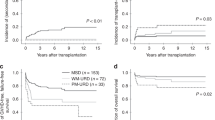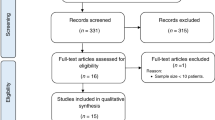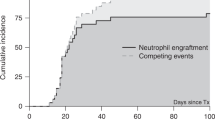Abstract
Treatment strategies for patients with severe aplastic anemia (SAA), depend on the severity of the disease, the age of the patient and the availability of a family donor. Progress in the past has included the early use of combined immunosuppressive therapy (IST) and better matching strategies to select unrelated donors. Currently, the actuarial 10-year survival in 2479 patients registered within the European Group for Blood and Marrow Transplantation (EBMT), is 73 and 68% for patients receiving first-line BMT or IST. The outcome of BMT has significantly improved since 1996, and this is true for both matched sibling donor BMT as well as for alternative donor BMT. Survival is significantly better in children (<16 years) as compared with adults (79 vs 68%, P<0.0001). In contrast, there has been no significant improvement over time for patients receiving IST. Again, results were significantly better in children compared with adults (81 versus 70%, P=0.001), especially in very severe aplasia (83 versus 62%, P=0.0002). This report outlines some of these results as a basis for treatment strategies in SAA.
This is a preview of subscription content, access via your institution
Access options
Subscribe to this journal
Receive 12 print issues and online access
$259.00 per year
only $21.58 per issue
Buy this article
- Purchase on Springer Link
- Instant access to full article PDF
Prices may be subject to local taxes which are calculated during checkout
Similar content being viewed by others
References
Marsh JC, Elebute MO . Stem cells in paroxysmal nocturnal haemoglobinuria and aplastic anaemia: increasing evidence for overlap of haemopoietic defect. Transfus Med 2003; 13: 377–386.
Bacigalupo A, Podestà M, Raffo MR, Piaggio G, Vimercati R, Risso M et al. Lack of in vitro colony formation and myelosuppressive activity in patients with sevre aplastic anemia after autologous hematologic reconstitution. Exp Hematol 1980; 8: 795.
Selleri C, Maciejewski JP, Sato T, Young NS . Interferon-gamma costitutively expressed in the stromal microenvironment of human marrow cultures mediates potent hematopoietic inhibition. Blood 1996; 87: 4149–4157.
Bacigalupo A, Valle M, Podesta M, Pitto A, Zocchi E, De Flora A et al. T-cell suppression mediated by mesenchymal stem cells is deficient in patients with severe aplastic anemia. Exp Hematol 2005; 33: 819–827.
Ascensao J, Kagan W, Moore M, Pahwa R, Hansen J, Good R . Aplastic anemia: evidence for an immunological mechanism. Lancet 1976; 1: 669.
Young NS . Autoimmunity and its treatment in aplastic anemia. Ann Intern Med 1997; 126: 166–168.
Podestà M, Piaggio G, Frassoni F, Pitto A, Zikos P, Sessarego M et al. The assesment of the hematopoietic reservoir after immunosuppressive therapy or bone marrow transplantation in severe aplastic anemia. Blood 1998; 91: 1959–1965.
Bacigalupo A, Brand R, oneto R, Bruno B, Sociè G, Passweg J et al. Treatment of acquired severe aplastic anemia: bone marrow transplantation compared with immunosuppressive therapy—The European Group for Blood and Marrow Transplantation Experience. Seminars in Hematology 2000; 37: 69–80.
Hill RS, Petersen FB, Storb R, Appelbaum FR, Doney K, Dahlberg S et al. Mixed hematologic chimaerism after allogeneic marrow transplant for severe aplastic anemia is associated with a higher risk of graft rejection and a lessened incidence of acute graft –versus host disease. Blood 1986; 67: 811–816.
McCann S, Passweg J, Bacigalupo A, Locasciulli A, Locatelli F, Ryan J et al. The influence of cyclosporin alone, or cyclosporin and methotrexate, on the incidence of mixed haematopoietic chimaerism following allogeneic sibling bone marrow transplantation for severe aplastic anaemia. Bone Marrow Transplant 2007; 39: 109–114.
Storb R, Erzioni R, Anasetti C, Appelbaum FR, Buckner CD, Besinger W et al. Cyclophosphamide combined with antithymocyte globulin in preparation for allogeneic marrow transplants in patients with aplastic anemia. Blood 1994; 84: 941–949.
Dulley FL, Vigorito AC, Aranha FJ, Sturaro D, Ruiz MA, Saboya R et al. Addition of low-dose busulfan to cyclophosphamide in aplastic anemia patients prior to allogeneic bone marrow transplantation to reduce rejection. Bone Marrow Transplant 2004; 33: 9–13.
Pierga JY, Socie G, Gluckman E, Devergie A, Henry-Amar M, Bridier A et al. Secondary solid malignant tumors occurring after bone marrow transplantation for severe aplastic anemia given thoraco-abdominal irradiation. Radiother Oncol 1994; 30: 55–58.
Locatelli F, Bruno B, Zecca M, Van-Lint MT, McCann S, Arcese W et al. Cyclosporin A and short-term methotrexate versus cyclosporin A as graft versus host disease prophylaxis in patients with severe aplastic anemia given allogeneic bone marrow transplantation from an HLA-identical sibling: results of a GITMO/EBMT randomized trial. Blood 2000; 96: 1690–1697.
Deeg HJ, Amylon ID, Harris RE, Collins R, Beatty PG, Feig S et al. Marrow transplants from unrelated donors for patients with aplastic anemia: minimum effective dose of total body irradiation. Biol Blood Marrow Transplant 2001; 7: 208–215.
Kojima S, Matsuyama T, Kato S, Kigasawa H, Kobayashi R, Kikuta A et al. Outcome of 154 patients with severe aplastic anemia who received transplants from unrelated donors: the Japan Marrow Donor Program. Blood 2002; 100: 799–803.
Bacigalupo A, Locatelli F, Lanino E, Marsh J, Socie G, Maury S et al. Fludarabine, cyclophosphamide and antithymocyte globulin for alternative donor transplants in acquired severe aplastic anemia: a report from the EBMT-SAA Working Party. Bone Marrow Transplant 2005; 36: 947–950.
Guidelines. In: Schrezenmeier H, Bacigalupo A (eds). Aplastic anemia: Pathophysiology and Treatment. 2000, pp 230–257.
Tichelli A, Socié G, Henry-Amar M, Marsh J, Passweg J, Schrezenmeier H et al. Effectiveness of immunosuppressive therapy in older patients with aplastic anemia. Ann Intern Med 1999; 130: 193–201.
Di Bona E, Rodeghiero F, Bruno B, Gabbas A, Foa P, Locasciulli A et al. Rabbit antithymocyte globulin (r-ATG) plus cyclosporine and granulocyte colony stimulating factor is an effective treatment for aplastic anaemia patients unresponsive to a first course of intensive immunosuppressive therapy. Br J Haematol 1999; 107: 330–334.
Schrezenmeier H, Marin P, Ragavachar A, McCann S, Hows J, Gluckman E et al. Relapse of aplastic anaemia after immunosuppressive treatment: a report from the European Bone Marrow Transplantation Group SAA Working Party. Br J of Haematol 1993; 85: 371–377.
Bacigalupo A, Bruno B, Saracco P, Di Bona E, Locasciulli A, Locatelli F et al. Antilymphocyte globulin, cyclosporine, prednisolone, and granulocyte colony-stimulating factor for severe aplastic anemia: an update of the GITMO/EBMT study on 100 patients. Blood 2000; 95: 1931–1934.
Ohara A, Kojima S, Hamajima N, Tsuchida M, Imashuku S, Ohta S et al. Myelodysplastic syndrome and acute myelogenous leukemia as a late clonal complication in children with acquired aplastic anemia. Blood 1997; 90: 1009–1013.
Gluckman E, Rokicka-Milewska R, Hann I, Nikiforakis E, Tavakoli F, Cohen-Scali S et al. Results and follow-up of a phase III randomized study of recombinant human-granulocyte stimulating factor as support for immunosuppressive therapy in patients with severe aplastic anaemia. Br J Haematol 2002; 119: 1075–1082.
Author information
Authors and Affiliations
Corresponding author
Rights and permissions
About this article
Cite this article
Bacigalupo, A. Treatment strategies for patients with severe aplastic anemia. Bone Marrow Transplant 42 (Suppl 1), S42–S44 (2008). https://doi.org/10.1038/bmt.2008.113
Published:
Issue Date:
DOI: https://doi.org/10.1038/bmt.2008.113
Keywords
This article is cited by
-
48/w mit zunehmenden spontanen Hämatomen am ganzen Körper
Der Onkologe (2022)
-
Rabbit-antithymocyte globulin combined with cyclosporin A as a first-line therapy: improved, effective, and safe for children with acquired severe aplastic anemia
Journal of Cancer Research and Clinical Oncology (2012)



